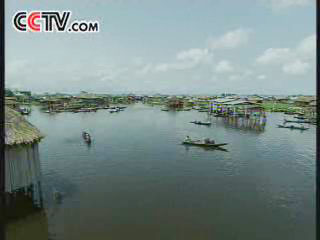Source: CCTV.com
10-25-2006 17:32
 |
Braving drizzle, the CCTV 'Into Africa' film crew departs from Algiers, the capital of Algeria, and embarks on their south-bound journey through the world's largest desert—the Sahara.
In the harsh Sahara Desert, 9.28 million square kilometers in area, temperatures during the day can reach as high as 54 degrees Celsius and drop to freezing point at night. Sandstorms are so strong they can bury humans and animals in just a few hours.
The journey across the desert starts from Algiers in the north and will end at Agadez of Niger in the south, traveling along an ancient trade route and a trunk highway across the central Sahara Desert.
Local African people dreamed that this asphalt road would push further southward to join the southern highway network, eventually connecting with Cape of Good Hope. However, this projected trans-African highway still remains just a dream to this day.
 |
Hundreds of years ago, travelers through the desert were only camel caravans in search of gold and slaves. To the Chinese film crew, the sounds of the camel bells on the ancient caravans seem to still linger on the vast desert.
But what we hear is, in fact, the melodious calls for prayer from a distant mosque.
In 1084, the Mozabite nomads, a branch of the Berber people, arrived in the Ghardaia basin. It is said they used the horns of bulls to dig their first ever well here and then settled around it. Today, Ghardaia has developed into a relatively important commercial and trade center. This is also the largest oasis town the Chinese filming crew has met after travelling 400 kilometers into the desert.
The central market was rebuilt by the city government in the late 1960s but still retains the traditional layout. Five streets, each 3 to 4 meters wide, radiate from here to other parts of the city. The north-south street leads to the city's oldest district—Melika.
Melika was the earliest urban center established by the Mozabites. After that, six more small towns were built on the slope to become the foundation for the development of Ghardaia.
The Mozabites are known for their more stringent religious doctrine being part of the Sunni sect of Islam. The Algerian government grants them an autonomous status, allowing them to carry out their religious observances in their own way.
 |
At the center of the town stands a towering mosque. Around it are row upon row of earthen dwelling houses built on the slope. Less than 7 meters in height, these houses have tiny windows shielded with screens or shutters to protect the privacy of the owners. Walking through the 2 to 3-meter-wide lanes makes the visitor feel the mystery of this ancient town. In public, Mozabite women have to cover themselves up in long and loose robes and veils.
Melika is only open to foreign tourists to a limited extent. According to the tour guide, our Chinese film team is the first of its kind from a foreign TV station that has been allowed to visit the town. There is a notice at the entrance of every street, stipulating regulations for visitors.
Since the founding of Melika, there has been little change in religious doctrine or social customs among the local Mozabite inhabitants. Houses are still built in the traditional way, with rough walls to deflect the scorching sunrays and narrow streets to fend off sandstorms. The most obvious change is perhaps the addition of wires and cables that can now be seen at most homes. People here, although little known to the outside world, are well-informed through watching television programs transmitted via satellite from all over the world.
Further south of Ghardaia, the sky becomes overshadowed by sand dust, revealing the true nature of the Sahara.
Editor:Wang Ping
